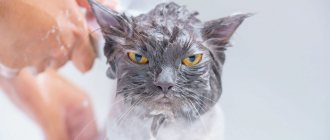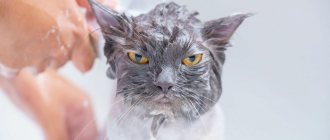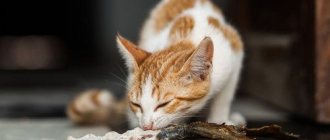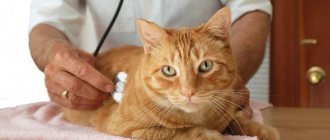Why pet fluffies develop a fear of water is interesting for any owner to know. Everyone knows that mustachioed individuals are excellent swimmers and, if necessary, can swim quite a long distance. A domestic predator does not mind hunting fish in an aquarium or touching an aquatic turtle in its habitat. But as soon as it comes to swimming, the phobia manifests itself with a vengeance.
Why cats don't like water
Experienced breeders, veterinarians and zoologists have long come to the conclusion that fluffies are not at all afraid of water as such. But there are various reasons why cats are afraid of water and don’t like to swim in it.
Temperature violation
The fur of a mustachioed friend is a kind of heat insulator, thanks to which he feels comfortable in any weather. If the hair is wet, it loses its protective properties, and the animal is left without a natural thermostat.
Bathing is scary primarily because the cat freezes after it. Violation of the protective air cushion leads to hypothermia of the body.
Moreover, it is more difficult for a mustachioed dog to dry out than for a dog. This is due to the peculiarity of the coat. Therefore, a bathed cat tries to lick itself faster in order to warm up.
Wet hair can also cause overheating. The air cushion prevents direct sunlight from reaching delicate skin, while wet fur does not have such properties.
Unstable position in the water space
Everyone knows that cats know how to land correctly on their paws when falling. However, while in the basin or bathtub, they are not confident in the abilities of their body. They have a slippery bottom under their paws, which makes it impossible for them to take a stable position.
A frightened purr cannot stand on all four limbs and balance with its tail. The owner holds the pet in such a way that he is not able to turn his head in the desire to examine what is happening. This frightens the animal very much and does not cause further desires to take a bath.
Inability to control the situation as usual
Pet purrs like to be in control and are always on the alert. During the washing process, it is difficult for them to maintain confidence in their own abilities. When wet, they feel defenseless, afraid of being attacked or aggressive by another creature.
This is the natural position of a domesticated pet, which has been formed over centuries. Only a mentally healthy pet that has been accustomed to the basin since childhood will feel comfortable while bathing.
Fear of liquid getting into ears, eyes, nose
The ear canals of a furry friend are different in structure from human ones. Therefore, fluid getting inside the ear brings not only discomfort and pain, but also serious problems. Most often, improperly bathed cats experience inflammation, otitis media, and develop dangerous ear infections.
Liquid getting into the eyes or nose causes acute pain in the pet. It is especially unpleasant if the water contains shampoo or other odorous chemicals. The mucous membranes begin to turn red, and irritation appears, which can bother the mustache for a long time.
Own and foreign odors
Wet wool emits a very intense aroma that even a person with a poor sense of smell can smell. For example, a family member suffering from chronic sinusitis or a chronic smoker.
Such a smell in natural habitats brings many problems to the animal, because it makes it defenseless against danger. In addition, a “fragrant” predator will not be able to count on a successful hunt.
Odors in the bathroom itself are also unpleasant for the cat. To him, the aromas of shampoo, conditioner and other chemicals seem many times more intense than to a person standing next to him. The smell of bleach emitted by tap liquid also repels your pet.
Instinct to protect against bacteria
Furry pets have very well developed natural instincts that protect them in different situations. They understand that wet wool becomes an excellent breeding ground for dangerous microorganisms.
From the surface of the body, these bacteria enter the stomach as a result of the pet’s natural desire to lick itself. As a result, the animal gets digestive problems and gastrointestinal disorders.
Of course, such problems cannot arise in purely domestic cats, but this cannot be explained by those with a mustache. Their desire to protect themselves from diseases is in their blood.
Fear of unusual sounds
The presence of unusual sounds in the bathroom also repels a mustachioed friend from taking bath procedures. So, a cat is afraid of the noise of water pouring from a tap or shower. Opening and closing a shampoo or conditioner bottle. Even the creaking of a rubber mat makes a wet individual want to be away from this place.
Evolution
Before they became pets, our purring pets were wild animals. They had to hunt in different conditions. However, most found their prey on land. The little predators had no need to swim for their dinner. They encountered water only as rain. And they hardly liked the fact that after a rain the cats became cold and wet.
But during the time that cats live with humans, which is 9,500 years, they have become unaccustomed to “wet” conditions. Therefore, the sensations when animals get into water can be called new for them. And it is wrong to say categorically that cats hate or are afraid of water. They are simply not used to such sensations.
Attitude of wild felines to water
Representatives of the cat family in the wild are both prey and predators. In the first case, they do not want to be tracked by scent. Since the enemy is ambushing the victim, they cannot have any scent to indicate their presence.
If wild specimens get wet, their fur will smell like swampy water. In addition, wet wool is excellent at collecting dirt and leaves. This means that a lot of extra time will be required for care. Therefore, wild cats are not very fond of water procedures.
However, even among wild representatives there are species that happily swim in bodies of water. For example, the speckled wiverine is not at all afraid of germs, disruption of thermoregulation and other consequences of getting wet. This individual will splash and dive deeply with great pleasure. Vivverins get their fish in this way. Another name for them is connected with this - fisherman.
Why wash?
Cat breeders with extensive experience clearly believe that pets need to be bathed in the following cases:
- in the presence of parasites, fleas, ticks in the coat;
- if serious contamination appears;
- as a means of prevention;
- during molting.
During coat changes, water treatments are required.
Cats shed periodically. When an animal licks its own fur, dirt and germs enter the body with saliva. During the molting period, the amount of fur increases and it is difficult for the pet to cope with its natural shedding. Thus, the digestive system of the pet is the first to suffer. To avoid this problem, it is recommended to combine the molting period with bathing the cat.
Breeds that favor water procedures
While not all Whiskered Purrs enjoy being in the water, some breeds enjoy swimming more than others. Moreover, their anatomical physique allows them to be excellent swimmers by nature.
Turkish Angoras are one of the breeds that love to swim, which is why they are often called “swimmers.” These representatives have a body perfectly adapted for being in an aquatic environment - they have long limbs with rounded paws.
Maine Coons are also big fans of baths, although they are considered one of the largest domestic breeds. Their robust bodies are suited to hold up well in unstable environments. Being in a filled bath, Maine Coons are happy to wallow and are ready to spend a lot of time there.
Bengals are also excellent swimmers, and because they are descended from Asian leopard relatives, they retain a natural instinct to splash and play in the water. They happily quench their thirst straight from the tap and are ready to sit in the sink all day in hot weather.
Sphynx cats do not have fur and therefore do not experience the inconvenience of getting wet. They tolerate bathing quite well, the main thing is to choose the right shampoos for them.
Representatives of the Rex breed have very short fur, which dries quickly after getting wet. A good-natured character, playfulness and a minimum of anger allow the owner to quickly accustom his curly pet to washing, especially if you put a toy in the basin or bathtub.
Other breeds that are ok with washing include the Kurilian, Japanese and American Bobtail, Norwegian Forest Cat, Mex and Abyssinian.
When to teach a kitten to bathe
The mother cat licks small kittens very diligently, but the sooner the baby is accustomed to water procedures, the better. The first bath determines whether the kitten will love water and how he will relate to it in the future.
If you adopted a kitten from a domestic cat, you should not bathe it immediately in the new home. For an animal, a change of place of residence and the loss of a mother cat is a great stress. Therefore, it is not necessary to introduce a kitten to the bathroom until 2.5-3 months of age. Another thing is a street kitten found or born by a stray cat. It should be washed as soon as the animal is brought home. It is important not only to wash off street dirt from the body, but also to get rid of fleas and other parasites that have settled on it. Therefore, you need to wash the kitten with special shampoos.
Even if the kitten gets dirty while eating or playing, you should not bathe it unless absolutely necessary. You can simply wipe its fur with a soft, damp sponge.
There is one more age-related feature - purebred cats begin to be taught to bathe later than “Russian pets”. Persians and Britons, Scottish Folds and some other breeds require special care for their fur, but taking care of the pet’s nervous system, it is not recommended to expose them to stress before 3-4 months of age.
How to train your pet not to be afraid of bathing
You need to get used to the process of bathing gradually. You should not bathe a kitten until 4 months of age - this can lead to severe hypothermia and a decrease in immunity.
Do cats need to be washed at all?
We must remember that the wild brothers and ancestors of modern domestic purrs were inhabitants of dry steppes who ate fresh prey and did not need additional drink. In addition, whiskers are very clean creatures that do an excellent job of tidying themselves up with the help of their tongue. By licking themselves, they break down contaminants with their bactericidal saliva and easily get rid of them.
A pet rarely needs to be washed by a person. Moreover, some veterinarians are against this procedure, because it is fraught with complications and is almost always accompanied by negative emotions.
You should not bathe your pet more than once a quarter, but it is better to carry out the procedure 2-3 times a year. The only exception may be an allergic reaction to the fur of a furry friend on the part of the owner and family members. Other reasons to wash your pet:
- the cat is not very clean;
- Dirt cannot be removed by regular licking;
- the wool gives off an unpleasant odor;
- ectoparasites (fleas, lice eaters, etc.) appeared on the body.
The need to use detergents is also associated with the prevention of skin diseases. In addition, if a handsome man with a mustache participates in exhibitions or championships, then he will have to be tidied up before each public appearance.
6 stages of training
A furry dog of any age will react negatively to the owner’s attempts to put him in the bath. Therefore, so that the cat is not afraid of water, it must be gradually accustomed to washing.
It’s good to start by introducing the mustache to the environment in the room. The animal must sniff everything, get used to unknown sounds and smells.
Experienced owners advise putting the animal in a dry bath and putting his favorite toys in there. Over time, the animal will stop panicking and running away. Then you can begin the first bath procedure. It occurs in several stages:
- Pour a few centimeters of water into a bathtub or basin and place a towel or mat there to prevent the mustache from slipping.
- Slowly lower the animal into the container.
- Wet your pet's fur. If he is calm, then you can turn on the shower.
- Lather your body with shampoo and massage thoroughly. Do not allow foam to get into your pet's ears, nose or mouth.
- Rinse off the shampoo and remove the cat from the container.
- Dry the wool with a towel and then wrap it in a dry sheet or other towel.
After bathing, it is not recommended to dry the animal's fur with a hairdryer. This can be scary and uncomfortable. The first wash should not last long. In the future, the duration of the procedure is determined individually.
Preparation rules
The bathing process can be divided into 3 stages:
- preparation;
- bathing;
- drying
When caring for your cat, you will definitely need a furminator.
Baths
You should remove all hanging towels in the bathroom, because if the cat breaks out, he will cling to them, tear them, pull out the ties, and throw them to the floor.
You also need to put away soap dishes, shampoos, washcloths - everything that can get under the pussy's paw. It is better to bathe the animal in a bathtub with a terry towel or rubber mat placed at the bottom so that its paws do not slip along the bottom.
For a small kitten, the size of the bath will be large and will cause fear, so it must be placed in a bowl or in a sink. Since a cat’s body temperature is 38–39 °C, a comfortable water temperature for her will be 38–40 °C. The air temperature in the bathroom should not be lower than 15 °C.
Water must be collected in advance so that its noise does not frighten the mustachioed one. Its volume should be so large that it reaches the animal’s abdomen—approximately 15–20 cm.
Important! Shampoo for bathing a cat must be purchased specially, taking into account the characteristics of its fur. You should not wash it with soap, as it dries out the skin.
Kota
Before you wash your cat in the bathroom, his claws need to be trimmed.
Find out how to make your own cat scratching post.
The animal should be bathed after visiting the tray.
After all the preparatory procedures, you can already start swimming.
Bacteria and dirt on wool
If an animal's fur is wet, it instantly becomes covered with dirt and dust. A cat, trying to lick its fur, does so along with dirt and bacteria, which, after entering the animal’s body, cause various diseases. Harmful microorganisms generally like to settle in damp areas, and such animal fur is an ideal place for reproduction. This is why zoologists say that a cat is naturally designed to “intuitively” recognize what is bad for it and what is good. She herself understands that she can introduce infections into her body, and therefore consciously tries to stay away from water and bodies of water.











